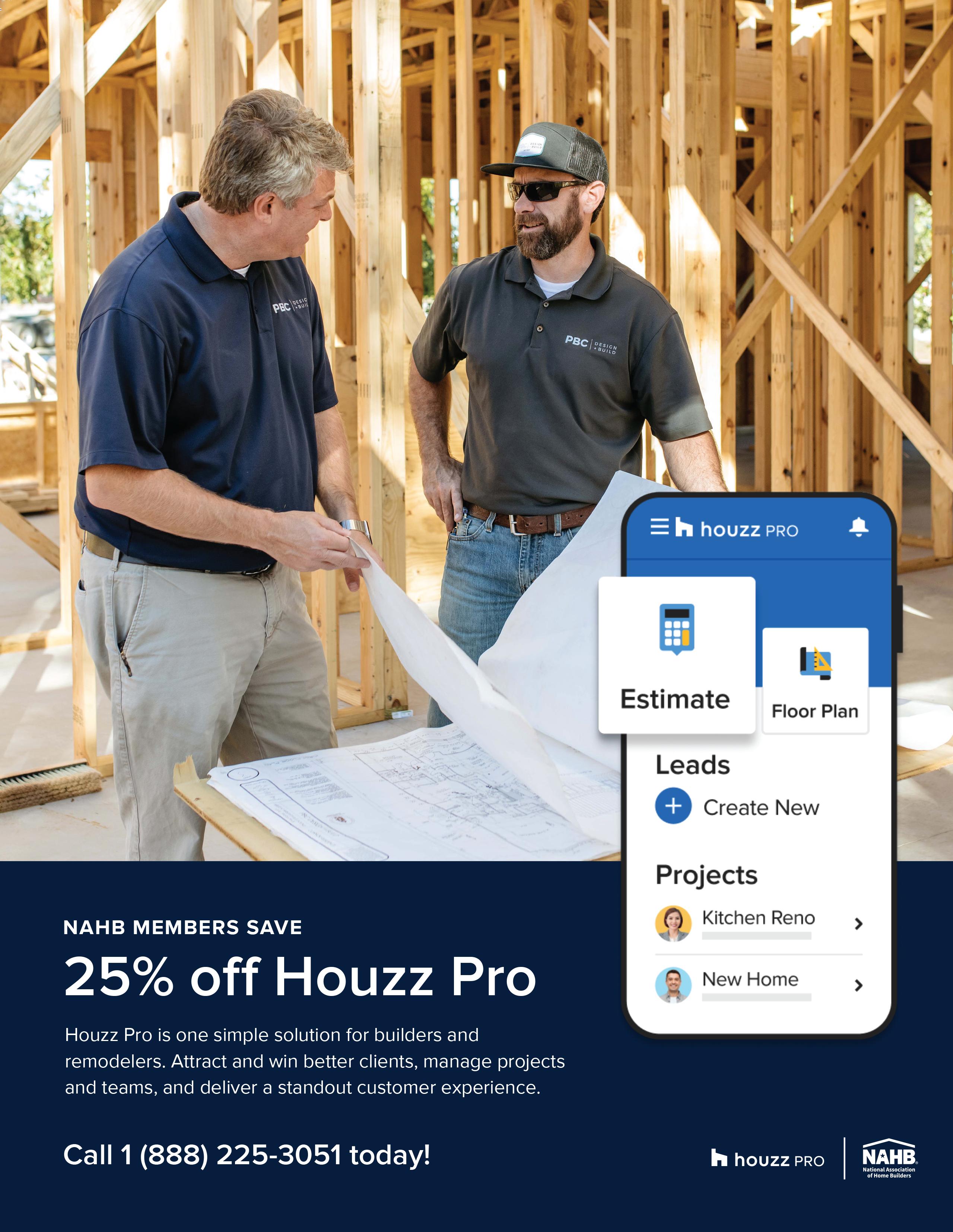










The official magazine of Home Builders Association of Middle Tennessee
President Kelly Beasley
Vice President Eli Routh
Secretary/Treasurer Danny Clawson
Executive Vice President John Sheley
Editor and Designer Jim Argo
Staff
Connie Nicley Kim Grayson
THE NAIL is published monthly by the Home Builders Association of Middle Tennessee, a non-profit trade association dedicated to promoting the American dream of homeownership to all residents of Middle Tennessee.
SUBMISSIONS: THE NAIL welcomes manuscripts and photos related to the Middle Tennessee housing industry for publication. Editor reserves the right to edit due to content and space limitations.
POSTMASTER: Please send address changes to: HBAMT, 9007 Overlook Boulevard, Brentwood, TN 37027. Phone: (615) 377-1055.
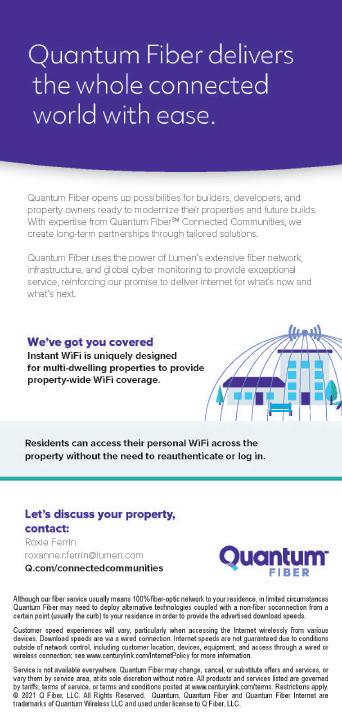
at the
International Builders Show in Las Vegas, Feb. 25 thru Feb. 27th.
The Federal Reserve paused on rate cuts at the conclusion of its January meeting. Robert Dietz breaks down the details.
The Sales & Marketing Council recognized the top sales agents and professionals of the year at the Installation Banquet.
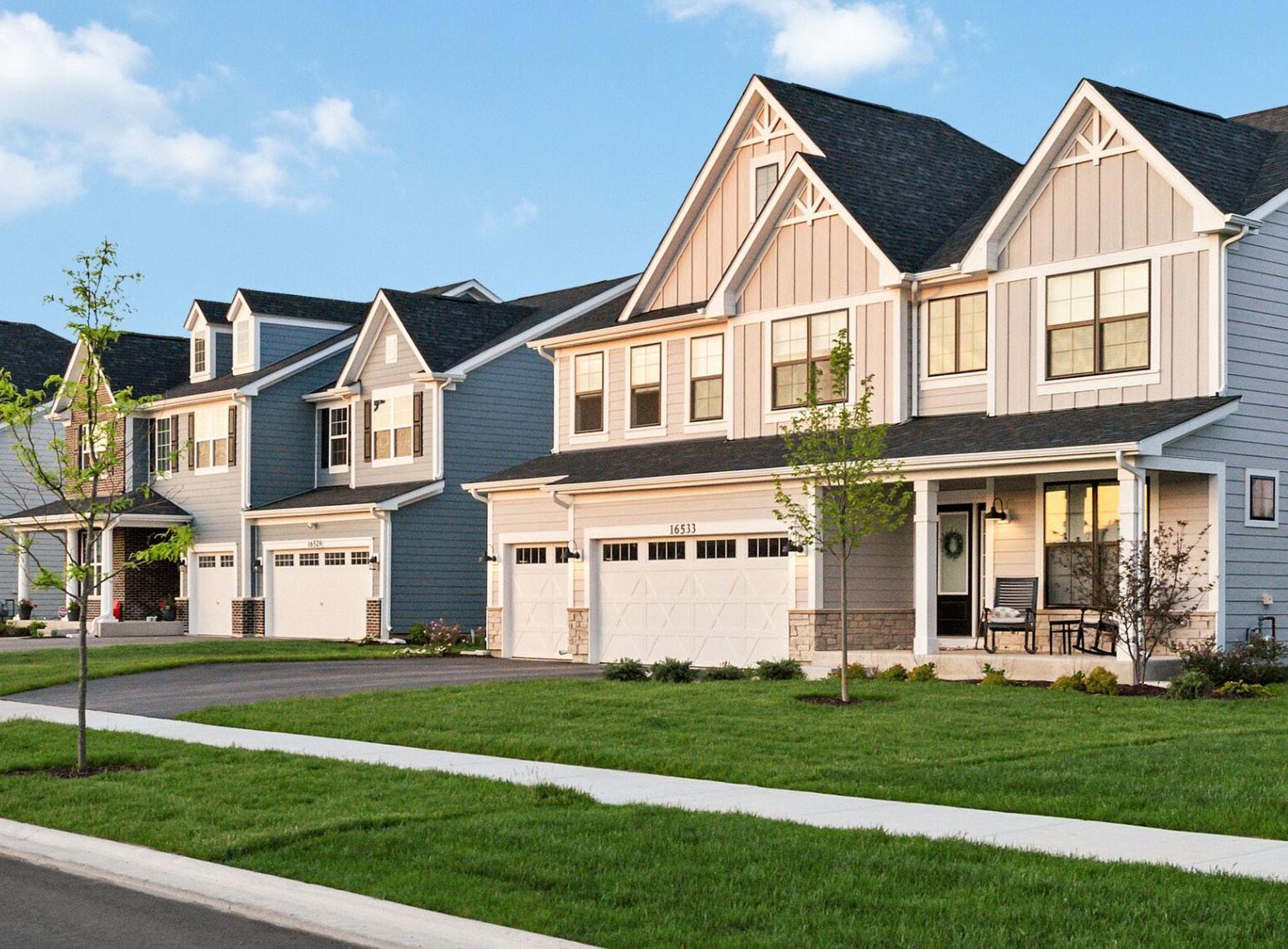
Alimited amount of existing inventory along with solid demand helped new home sales end the year on an up note, even as buyers continue to grapple with housing affordability challenges.
Sales of newly built, single-family homes in December increased 3.6% to a 698,000 seasonally adjusted annual rate from an upwardly revised November number, according to newly released data from the U.S. Department of Housing and Urban Development and the U.S. Census Bureau. The pace of new home sales in December was up 6.7% compared to a year earlier.
“New home sales ended 2024 higher on ongoing limited resale inventory conditions,” said Carl Harris, chairman of the National Association of Home Builders (NAHB) and a custom home builder from Wichita, Kan. “Builders are cautiously optimistic about the building market for 2025 given a post-election policy reset that seeks to eliminate unnecessary regulations.”
“New home sales ended the year 2.5% higher over the 2023 total,” said NAHB Chief Economist Robert Dietz. “NAHB is forecasting a slight gain for sales in 2025 given ongoing solid macroeconomic conditions, particularly for the labor market.”
A new home sale occurs when a sales contract is signed, or a deposit is accepted. The home can be in any stage of construction: not yet started, under construction or completed. In addition to adjusting for seasonal effects, the December reading of 698,000 units is the number of homes that would sell if this pace continued for the next 12 months.
New single-family home inventory in December continued to rise to a level of 494,000, up 10% compared to a year earlier. This represents an 8.5 months’ supply at the current building pace. Completed ready-to-occupy inventory is up 46% to a level of 118,000, compared to a year ago.
NAHB estimates the combined new and existing total months’ supply (8.5 months’ supply for new homes while the much larger resale market was at 3.1) fell to just a 4 months’ supply in December, the lowest since April 2024. The market has not been near a 6 months’ supply, which represents a balanced market, since 2012.
The median new home sale price in December was $427,000, up 2.1% from a year ago.
Regionally, on a year-to-year basis for 2024 totals, new home sales were strongest in the Midwest, up 19% in 2024. Sales also rose 1.7% in the Northeast and 2.6% in the West but declined 0.2% in the South n

Fueled by solid demand, single-family construction moved higher in December despite several headwinds facing the industry, including high mortgage rates, elevated financing costs for builders and a lack of lots.
Overall housing starts increased 15.8% in December to a seasonally adjusted annual rate of 1.50 million units, according to a report from the U.S. Department of Housing and Urban Development and the U.S. Census Bureau. This is the highest rate since February 2024.
The December reading of 1.50 million starts is the number of housing units builders would begin if development kept this pace for the next 12 months. Within this overall number, single-family starts increased 3.3% to a 1.05 million seasonally adjusted annual rate. The multifamily sector, which includes apartment buildings and condos, increased 61.5% to a 449,000 pace.
Total housing starts for 2024 were 1.36 million, a 3.9% decline from the 1.42 million total from 2023. Single-family starts in 2024
totaled 1.01 million, up 6.5% from the previous year. Multifamily starts ended the year down 25% from 2023.
“Single-family home building increased 6.5% for 2024, as builders added more supply in a market continuing to face a housing affordability crisis due to elevated mortgage interest rates and higher construction costs,” said Carl Harris, NAHB chairman. “Nonetheless, the industry expects to see a slight gain for single-family home building in 2025 because of a persistent housing shortage and ongoing solid economic conditions.”
“While December was a solid month for apartment starts, the sector ended 2024 down 25% in terms of total starts,” said NAHB Chief Economist Robert Dietz. “In December, and on a three-month moving average basis, there were 1.7 apartments completing construction for every one apartment starting construction. Multifamily construction will stabilize later in 2025 as more deals pencil out, with the industry supported by a low national unemployment rate.”
The National Association of Home Builders (NAHB) released its NAHB/Westlake Royal Remodeling Market Index (RMI) for the fourth quarter, posting a reading of 68, up five points compared to the previous quarter.
The NAHB/Westlake Royal RMI survey asks remodelers to rate five components of the remodeling market as “good,” “fair” or “poor.” Each question is measured on a scale from 0 to 100, where an index number above 50 indicates that a higher share view conditions as good than poor. The results are seasonally adjusted.
The Current Conditions Index is an average of three components: the current market for large remodeling projects, moderately-sized projects and small projects. The Future Indicators Index is an average of two components: the current rate at which leads and inquiries are coming in and the current backlog of remodeling projects. The overall RMI is calculated by
averaging the Current Conditions Index and the Future Indicators Index. Any number over 50 indicates that more remodelers view remodeling market conditions as good than poor.
“Remodelers are more optimistic about the market than they were earlier in the year,” said NAHB Remodelers Chair Mike Pressgrove, a remodeler from Topeka, Kan. “Demand in many parts of the country was stronger than usual for the fall season, especially demand for larger projects, with leads coming in after the uncertainty about the November elections was removed.”
“The increase in the 4th quarter RMI was driven to a great degree by demand for large projects,” said NAHB Chief Economist Robert Dietz. “Not only did the current conditions index for $50,000-plus projects show the greatest increase during the quarter, but the share of remodelers doing whole house remodeling
Looking at regional housing starts data for 2024, combined single-family and multifamily starts were 9.1% higher in the Northeast, 0.1% lower in the Midwest, 5.2% lower in the South and 7.7% lower in the West.
Overall permits decreased 0.7% to a 1.48-million-unit annualized rate in December and were down 3.1% compared to December 2023. Single-family permits increased 1.6% to a 992,000-unit rate but were down 2.5% in December compared to the previous year. Multifamily permits decreased 5.0% to a 491,000 pace.
Looking at regional permit data for 2024, permits were 1.5% higher in the Northeast, 3.5% higher in the Midwest, 3.1% lower in the South and 6.6% lower in the West.
Total permits for 2024 were 1.47 million, a 2.6% decline from the 1.51 million total from 2023. Single-family permits in 2024 totaled 981,000 up 6.6% from the previous year, a positive sign for 2025.
The number of single-family homes under construction was down 5.3% from a year ago, at 641,000 homes. The number of apartments under construction was down 21% from a year ago, at 790,000. The count of apartments under construction peaked in July 2023 at 1.02 million and has been trending lower since that time n
reached a record high of 62%. This has significant implications for supply chains because large remodeling projects are more likely to use building products purchased directly from the manufacturer, or a manufacturer’s distribution center, rather than a retail outlet.”
The Current Conditions Index averaged 75, increasing three points compared to the previous quarter. All three components remained well above 50 in positive territory: the component measuring large remodeling projects ($50,000 or more) rose eight points 75, the component measuring moderate remodeling projects (at least $20,000 but less than $50,000) increased two points to 73, and the component measuring small-sized remodeling projects (under $20,000) inched down one point to 76.
The Future Indicators Index averaged 61, up six points compared to the previous quarter. The component measuring the current rate at which leads and inquiries are coming in jumped nine points to 62, and the component measuring the backlog of remodeling jobs rose two points to 59 n


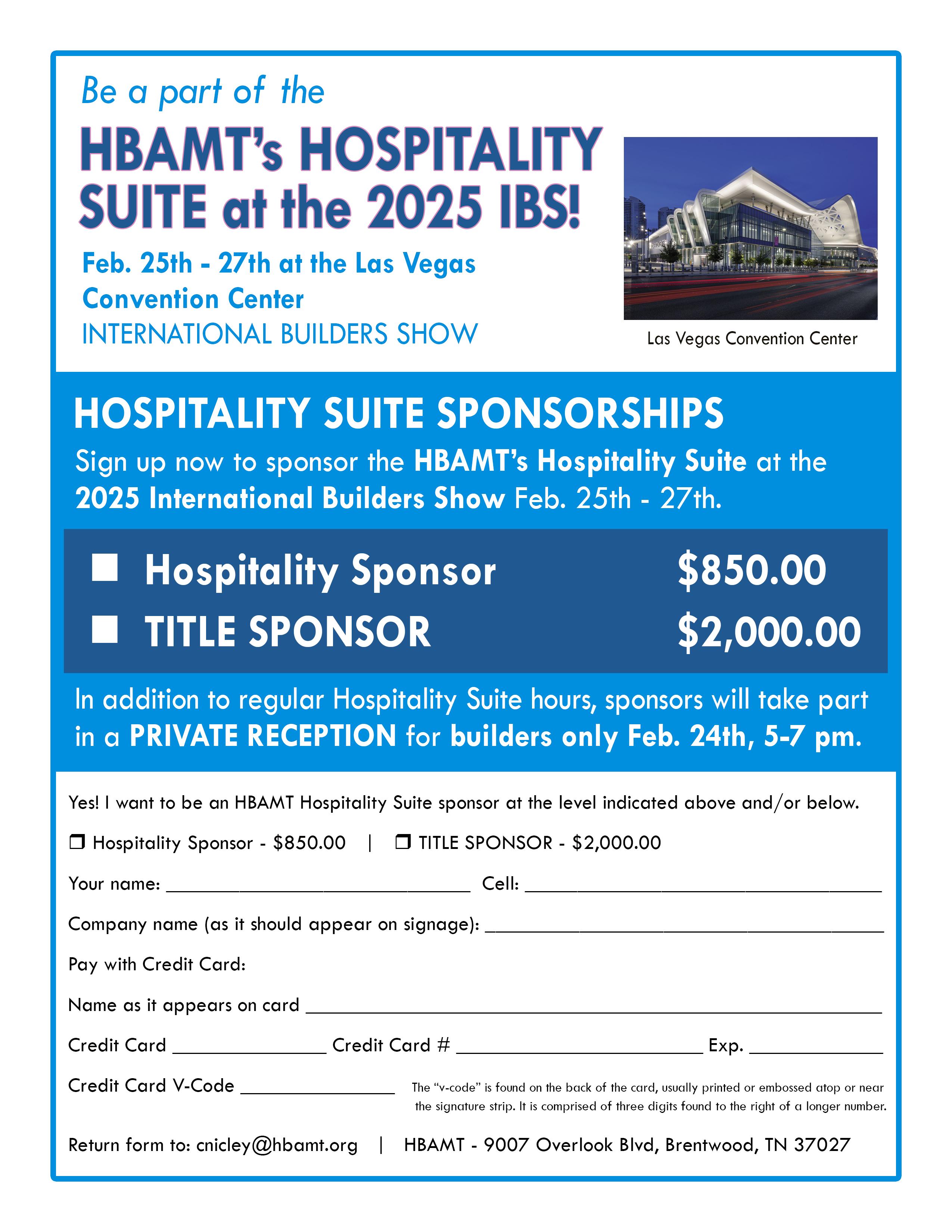

- by Robert Dietz, NAHB Chief Economist
In a widely anticipated announcement, the Federal Reserve paused on rate cuts at the conclusion of its January meeting, holding the federal funds rate in the 4.25% to 4.5% range. The Fed will continue to reduce its balance sheet, including holdings of mortgage-backed securities. The Fed noted the economy remains solid, while specifying a data dependent pause. Chair Powell did qualify current policy as “meaningfully restrictive,” but the central bank appears to be in no hurry to enact additional rate cuts.
While the Fed did not cite the election and accompanying policy changes today, the central bank did note that its future assessments of monetary policy “will take into account a wide range of information, including readings on labor market conditions, inflation pressures, and inflation expectations, and financial and international developments.” Given the ongoing, outsized impact that shelter inflation is having on consumers and inflation, an explicit mention to housing market conditions would have been useful in this otherwise exhaustive list.
Chair Powell did state in his press conference that housing market activity appears to have “stabilized.” A reasonable assumption is that this is a reference to an improving trend for rent growth (for renters and owners-equivalent rent), but the meaning of this statement is not entirely clear given recent housing market data and challenges. While improving, shelter inflation is running at an elevated 4.6% annual growth rate, well above the CPI. These housing costs are driven by continuing cost challenges for builders such as financing costs and regulatory burdens, and other factors on the demand-side of the market like rising insurance costs. And more fundamentally, the structural housing deficit persists.
From the big picture perspective, the Fed faces competing risks for
future policy given changes in Washington, D.C. Tariffs and a tighter labor market from immigration issues represent upside inflation risks, but equity markets have cheered prospects for an improved regulatory policy environment, productivity gains and economic growth due to the November election. These crosswinds may signal a lengthy pause for monetary policy as the Fed continually seeks more short-term data.
While the Fed targets short-term interest rates, long-term interest rates have risen significantly since September, as a second Trump win came into focus. A future risk for long-term interest rates and inflation expectations will be fiscal policy and government debt levels. Extension of the 2017 tax cuts will be good for the economy, but ideally these tax reductions should be financed with government spending cuts. Otherwise, a larger federal government debt will place upward pressure on long-term interest rates, including those for mortgages.
The January Fed statement acknowledged the central bank’s dual mandate by noting that it would continue to assess the “balance of risks.” There was no language in today’s statement pointing to a future cut, although markets still expect one or two reductions in 2025 if inflation remains on a moderating trend.
Importantly, the Fed reemphasized that it is “strongly committed to support maximum employment and returning inflation to its 2 percent objective.” That seemed like a shot across the bow for those speculating that the Fed might be satisfied with achieving an inflation rate closer to but not quite 2%. While there is merit to debating the 2% policy, the emphasis today on the 2% target is a reminder of how important the housing market and housing affordability is for monetary policy and future macroeconomic trends n


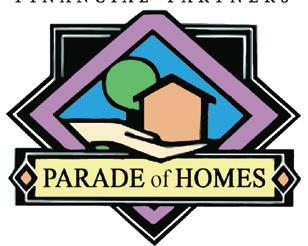
The 2025 Parade of Homes at Rosebrooke
THE PARADE PLAN BOOK
At every Parade event each attendee is handed a magazine as they walk through the front gate - the Parade Plan Book
The Plan Book is a tremendous opportunity to put your message into the hands of pre-qualified customers who refer to the book several months after the Parade of Homes is over!
Plan Book Advertising Rates
Half Page 7.5” x4.75” (Horizontal) $960
Full Page 7.5”x10” 8.75”x 11.25” (B1eed) $1,440
Page One 7.5”x10” 8.75”x11.25” (Bleed) $1,920
Inside Front Cover
Inside Back Cover
Double Truck
Back Cover
$2,520
$2,760
$3,410
$3,900
Email jargo@hbamt.org for ad specs and availability.
If your company depends on new homes or related products, furnishings or services, here’s one opportunity you can’t pass up -- the 2025 Parade of Homes at Rosebrooke! Secure your space in the Plan Book or reserve an Exhibit Booth today.
Here’s your chance to demonstrate your product or service to the thousands of qualified prospects who pass through the Parade of Homes exhibit center when they enter and leave the show. As with Plan Book advertising, the exhibit center produces virtually all pre-qualified customers!
It’s like opening up shop and having thousands of prospects visit your show room the first two weeks you’re in business. What other medium could come close to producing those kinds of results? The Parade ranks first of all home shows in the nation and you can take advantage of the prestige this show enjoys.
Exhibit Booth Price? $750
Each booth in the Parade of Homes exhibit center measures 10’ x 6’ at the front entrance where patrons must enter and exit -- perfect for eye-popping kiosks and marketing publications!
2025 PARADE OF HOMES - PROMOTIONAL OPPORTUNITIES COMMITMENT FORM
Return completed form to: HBAMT, 9007 Overlook Blvd., Brentwood, TN 37027 | Email: jargo@hbamt org
PLAN BOOK AD - please check the size of ad you would like to secure in the 2025 Plan Book: r Half Page r Full Page r Page One r Inside Front r Inside Back r Back Cover r 2-Page Spread
EXHIBIT BOOTH SPACE - please check here to secure your 2025 Exhibit Booth Space: r Your name:
Eighteen SPIKES (in bold) increased their recruitment numbers last month. What is a SPIKE? SPIKES recruit new members and help the association retain members. Here is the latest SPIKE report as of December 31, 2024.

CHEATHAM COUNTY CHAPTER
Chapter President - Roy Miles
Cheatham County Chapter details are being planned.
Next meeting: to be announced.
RSVP to: cnicley@hbamt.org
DICKSON COUNTY CHAPTER
Chapter President - Mark Denney
Dickson County Chapter details are currently being planned.
Next meeting: to be announced.
Price: FREE, lunch dutch treat.
RSVP to: cnicley@hbamt.org
MAURY COUNTY CHAPTER
Chapter President - Sam Gray
Maury County Chapter details are currently being planned.
Next meeting: to be announced.
RSVP to: cnicley@hbamt.org
METRO/NASHVILLE CHAPTER
Chapter President - Tonya Esquibel
Metro/Nashville Chapter details are currently being planned.
Next meeting: to be announced.
Topic: to be announced.
RSVP to: cnicley@hbamt.org
ROBERTSON COUNTY CHAPTER
Robertson County Chapter details are currently being planned.
Next meeting: to be announced.
RSVP to: cnicley@hbamt.org
SUMNER COUNTY CHAPTER
Chapter President - Joe Dalton
The Sumner County Chapter typically meets at the new Hendersonville Library. Future meetings to be announced.
Next meeting: to be announced.
RSVP to: cnicley@hbamt.org
WILLIAMSON COUNTY CHAPTER
Chapter President - Rachel Holloway Williamson County Chapter details are being planned. Next meeting: to be announced.
RSVP to: cnicley@hbamt.org
WILSON COUNTY CHAPTER
Chapter President - Margaret Tolbert
Next meeting: Thursday, February 13th, 11:30 a.m. East Nashville Beer Works - Wilson County Taproom 1688 Callis Rd, Lebanon, TN 37090 (upstairs)
Topic: "The State of Wilson County 2025," with guest speaker Wilson County Mayor Randall Hutto. The Mayor will share insights on the developments, priorities, and goals for the county in the coming year
Free with RSVP thanks to Concordia Insurance! RSVP to: cnicley@hbamt.org
HBAMT REMODELERS COUNCIL
The HBAMT Remodelers Council meets at varying locations throughout the year.
Next meeting: to be announced.
RSVP to: cnicley@hbamt.org
INFILL BUILDERS COUNCIL
Infill Builders Council details are currently being planned. Next meeting: to be announced.
MIDDLE TENN SALES & MARKETING COUNCIL Council President - Chuck Payne
The SMC typically meets on the first Thursday of the month. Next meeting: Thursday, February 6th, 9:00 a.m. at the HBAMT - 9007 Overlook Blvd., Brentwood, TN 37027
Topic: "Selling Lifestyle, Not Just Homes," with special guest Kelly Beasley, 2025 HBAMT President, Chapter 2 Development. oin the SMC in February as Kelly discusses how to shift your customer's focus from square footage to the lifestyle offered by a new home community. Key takeaways will include techniques for storytelling, highlighting your amenities, promoting community events, and selling neighborhood culture.
SMC Members Free w/RSVP thanks to Regent Homes! Non-SMC members: $15 with RSVP; $20 w/o RSVP RSVP REQUIRED DUE TO LIMITED SEATING RSVP to: cnicley@hbamt.org
